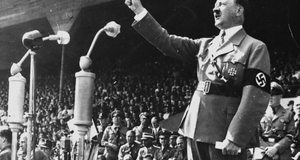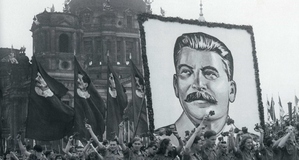Hitler's Use of Film in Germany, Leading up to and During World War II
By
2010, Vol. 2 No. 03 | pg. 2/2 | « However, when a young girl, Maria, preaching the ideals of equality and freedom, captures the hearts of the workers, the fascist state is thrown into turmoil and eventually overthrown as the people revolt, refusing to accept their harsh treatment any longer. By capturing the true plight of the workers, through the filming of them walking to and from work like lost drones and the images of their subhuman, underground “homes,” Lang assuages the viewer to their cause. When Maria arrives and leads them to revolt, casting off the chains of oppression, the viewer is with them every step of the way, cheering them on. At first glance (at the time of its original creation), Riefenstahl’s Triumph des Willens seems to embody a similar spirit to Metropolis. Purported as a documentary of the Nazi Party rallies in Nuremberg in 1934, it delivers a message of a society, cast out and oppressed by the outside international community, which is finally climbing back onto its feet through the guidance of a hero, a god-like legend, Fuhrer Adolph Hitler. In the film, Hitler speaks of unity and equality, claiming Germany was a society on the fringes of death as a result of the rest of the world’s discrimination and now they will rise up and give birth to a new peaceful order of equality. If one were to examine these two films at the time of their releases, they would seem to carry almost exact messages of rebellion against unjust oppression and of equality for all women and men despite class, rank, race, or religion.Hitler preaches for peace and equality several times through out the film. During the massive Hitler Youth rally, he states, “And we want that you, German boys and girls, to absorb everything that we wish for Germany. We want to be one people and through you, to become this people. We want a society with neither castes nor ranks and you must not allow these ideas to grow within you. We want to see one Reich. And you must educate yourselves for this. We want this people to be obedient and you must practice this obedience in yourselves. We want this people to be peace-loving, but at the same time to be courageous. And you, for that reason, must be both peace-loving and strong” (Triumph des Willens, 1934). In this speech, Hitler clearly states his and the Nazi party’s wishes for an equal rights society and peace. This is a major point of the film that the viewer is constantly bombarded by throughout the course of the four day event. Even at the same rally, Baldur Von Schirach, the Reich Youth Leader, claims, “According to your command, my leader, a youth stands here, a youth that knows neither class nor caste. The young generation of our people follows after you. Just as you demonstrate the highest self-sacrifice in this Nation so does this youth wish to be self-less. Because you embody the concept of fidelity to us therefore we wish to be faithful” (Triumph des Willens, 1934). Again, the desire for a society of no rank or class is expressed. According to the film and its message, Hitler attempts to build an equal rights society with no class separations as seen in Metropolis. However, in reality, this is a severe manipulation of the truth by Riefenstahl and Hitler. Hitler’s message of equality is a false front, a mere attempt to coax German people sitting on the political fence to his party’s side. In reality, brutal class lines were drawn within German society. Anti-Semitism ran rampant. This hate for the Jewish was so intense that it climaxed in the creation of concentration camps to exterminate the entire race. The German’s hatred was not limited to the Jewish either. Their sphere of hatred extended to gypsies, communists, Slavs, Poles, the mentally handicapped, etc. In their secret mission to create a master race, they basically discriminated against and later butchered anyone that was not a German Caucasian. Is this the actions of a supposedly equal society? Riefenstahl’s careful manipulation of the truth involved a disgusting sifting process of separating reality from fantasy, painting a false façade of the new rising German order. Triumph des Willens is uncovered as a documentary, in the loosest sense of the word, that purports anything but this message and is simply created as a propaganda piece to convince all Germans to join the Nazi movement, utilizing the previous films glamour and ideals to fuel their cause. The third factor that solidifies the idea that Triumph des Willens attempts to copy and capture the power of Metropolis involves the manner in which both movies were filmed. Metropolis is marketed and actually is a fictional narrative film, shot like any other movie with multiple takes, choreographed shots, and editing in order to accelerate the pace. This is the manner in which almost all fictional narrative films are photographed during production and manipulated in post production, mainly because they are just that, fictional. Triumph des Willens purports to be a documentary of the Nuremberg rallies, capturing the event in a realistic, unbiased manner. “Riefenstahl, for example, claimed that Triumph des Willens simply documented an unstaged event” (Bordwell, 313). However, if it is an actual documentary, it is a documentary in the loosest sense. A documentary film, by definition, captures a story from an outsider’s perspective, photographing events as they transpire without interfering or setting any pre-planned events up for the project. Triumph des Willens breaks this definition on every level, in every manipulative manner. As Frumkes states, “Under her direction, Hitler’s stock company - the Nazi party members - would be made to do retakes of huge Busby Berkeley-like numbers, overhead shots and all. For the nighttime scenes, Riefenstahl utilized aerial searchlights that had been requisitioned from the Luftwaffe for her use. And the flow of events with the movie’s final cut was not chronological, neither in the case of whole sequences, nor even of shots with sequences. The director/editor went for filmic rhythm over realism. It was the antithesis of an objective work: it was a personal document of power, national symmetry and technique by one of the very best filmmakers” (Triumph des Willens, 1934 – DVD pamphlet). Clearly, Riefenstahl manipulated events for the viewers, creating a work of cinematic power and strength in order to allure viewers rather than tell them the truth. The film is not a documentary as Frumkes explains, but more of a staged, massive production funded by the UFA in order to produce a major influential propaganda work about the Nazi party and its supposed beliefs. “He (Hitler) put enormous resources at her disposal. She oversaw sixteen camera crews, and the huge buildings erected for the event were designed to look impressive in the film” (Bordwell 309). Not only did he provide the entire Nazi Party as actors, but he provided Riefenstahl with unlimited funds and backing for the project, hoping to cultivate his dream project and see it become a reality. Frumkes continues in his article, “Nothing is quite real in this film. The opening cloud shots, symbolizing Hitler’s godlike presence hovering above the city, was a device used in the “Mountain” films to the point of cliché. Near the beginning, when the Fuhrer’s motorcade triumphantly enters the populace-thronged streets of Nuremberg, the camera is positioned two feet in back of him in his specially made Mercedes Benz 770. And yet, when we cut to a long shot, suddenly there’s no camera in the care…Particularly in light of today’s more film-savvy audiences, one can’t help considering how many times the procession was filmed at the director’s request to get all the coverage she needed. At one point during the ride there’s a shot of a cat on a window ledge, after which Riefenstahl cuts to Hitler looking up and smiling as if he not only spotted the feline, but also loved animals” (Triumph des Willens, 1934 – DVD pamphlet). Due to the lack of knowledge of moviegoers at the time, Riefenstahl was able to manipulate her images and shots to convince and allure the audience to the Nazi cause. Siegfried Kracauer, author of From Caligari to Hitler, drew a direct parallel between the filming of the two films. “Equally damaging was Kracauer’s analysis of what he termed the ‘mass ornament’ in Lang’s film, and which he saw as having inspired Leni Riefenstahl’s Triumph des Willens” (Bachmann, 132). The concept of ‘mass ornament’ involves the idea of getting a massive amount of people to participate in a film based on the fascination of ‘being there’ or ‘being in it.’ Riefenstahl used this to her advantage to get massive crowds to do retake after retake for free. Through her crafty editing and carefully choreographed shots, she personified Hitler as a godlike figure in German society and the Nazi party as a glamorous, highly-moral group fighting for peace and equality. In conclusion, Triumph des Willens is a propaganda reinvention of Metropolis through the eyes of the sadistic Fuhrer Adolph Hitler, envisioning himself as the hero of his people, and misguided artist Leni Riefenstahl, both attempting to convince the German people of the Nazi Party’s “noble” cause that, in reality, represents every ideal the original Metropolis stood against. After careful examination, Triumph des Willens emerges as many different things: a fantasy, a farce, a drama, a comedy, a spectacle, and even a musical. However, the one thing that it really is not is a documentary, which it purports to be. The manipulation of reality is painfully obvious, and it begs the terrifying question of whether or not our own society has been subject to similar propaganda tactics in the past or the present. ReferencesBachmann, Holger, and Michael Minden. Fritz Lang’s Metropolis: Cinematic Visions of Technology and Fear. New York: Camden House, 2000. Bordwell, David and Kristin Thompson. Film History: An Introduction. New York: McGraw – Hill, Inc., 1994. McGilligan, Patrick. Fritz Lang: The Nature of the Beast, a Biography. New York: St. Martin’s Press, 1997. Metropolis. Fritz Lang (director), Erich Pommer (producer), and Fritz Lang and Thea von Harbou (writers). DVD. Universum Film A.G. (UFA), 1927. Triumph des Willens. Leni Riefenstahl (director/producer), Leni Riefenstahl and Walter Ruttmann (writers). DVD. Leni Riefenstahl-Produktion [de], 1934 Suggested Reading from Inquiries Journal
Inquiries Journal provides undergraduate and graduate students around the world a platform for the wide dissemination of academic work over a range of core disciplines. Representing the work of students from hundreds of institutions around the globe, Inquiries Journal's large database of academic articles is completely free. Learn more | Blog | Submit Latest in Film & Media |
















